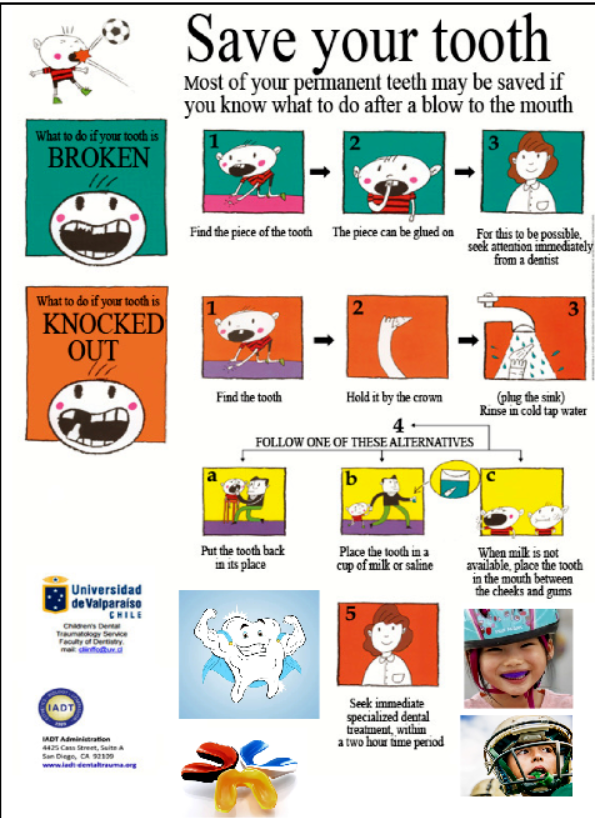Physical Education Teacher : A Hardcore Tooth Saver
Dr. Rumisa Nazim Kashani
According to the American Academy of Pediatric Dentistry’s policy on Prevention of sportsrelated orofacial injuries, sports mishaps account for 10-39% of all dental injuries in children.”
The most common type of injury reported by the coaches are ‘cut lip, cheek, and tongue’ (72.6%), followed by ‘broken/avulsed tooth’ (44.9%).The preventive and emergency care knowledge possessed by sports coaches is deemed to be significant as they are at the site of injury and will be the first to decide the primary first aid given to the child and it’s future course of action.
Any postponement in immediate treatment or inappropriate treatment due to lack of knowledge may lead to the futile outcome of the injured teeth.
The Pediatric population at higher risk for sports related injury are with proclination of anterior teeth, incompetent lips (inability to seal the lips at rest ) , history of previous dental trauma , obesity and attention deficit / hyperactivity disorders (ADHD). An immediate action on the site of injury by a the teacher at school can save a child from grievous consequences and be a hand in glove support for the Pedodontist at saving those precious gems at the earliest.

Sports Dentistry has two major components:
First is the treatment of orofacial injuries and the second is the prevention of sports?related orofacial injuries.
TREATMENT
The most common sports injury reported to the dental emergency are the broken tooth and avulsion injuries in children. Adequate measures taken at the site proves to be beneficial for the child.
- Broken tooth management :
Step 1 : Stay calm
Step 2: Save the fragment – Keep the fragment immersed in a container containing normal saline or distilled water
Step 3: Keep the injurious area clean by giving a rinse to the child.
Step 4: Visit the dentists as soon as possible for further treatment .
2 . Management of Avulsion (Complete dislodgement of tooth from the socket)
A) Primary tooth /Milk tooth
Step 1 : Keep calm
Step 2: Control bleeding on site of injury by giving a pressure pack using cotton. In case of swelling , give cold compressions using an ice pack.
Step 3: Do Not try to reposition the tooth in the socket.It can harm the developing permanent tooth bud.
Step 4: Visit a pedodontist as soon as possible for further management.
B) Permanent tooth
Step 1 : Keep calm
Step 2: Hold the tooth from the crown portion and not the root(the part within the bone)
Step 3:Rinse under tap water.
Step 4: Rinse the mouth with clean water in case any gross impurities (mud , pebbles ) present at the site of injury .
Step 5: Try to reposition the tooth into the socket using finger pressure.
In case not possible, immerse the tooth in a container containing either cold milk ( within 20 mins), coconut water, Gatorade (a non carbonated beverage consumed by non athletes as a snack).
Commercially available storage media that can be kept in schools are Hank’s balanced salt solution (SAVE-A-TOOTH) and ViaSpan.
Step 6 : Visit a pedodontist as soon as possible for further management.
PREVENTIVE MEASURES
A very well known proverb “Prevention is better than cure”, holds true in Traumatic Dental Injury prevention. Various preventive measures are available as follows.
* Mouth guard : A mouthguard is a device worn in the mouth while playing contact sports which help reduce the force of the blow to the face, thus reducing the risk of broken teeth and injuries to your lips, tongue, face or jaw. They typically cover the upper teeth and are a great way to protect the soft tissues of your tongue, lips and cheek lining.
There are three types of mouth-guards:
* Ready-made or stock mouthguard
* Mouth-formed “boil and bite” mouthguard
* Custom-made mouthguard (made by a dentist)
* Faceguards : Use of full face shields is associated with significantly reduced risk of sustaining facial and dental injuries. A face guard , along with the chinstrap must be used in order to protect injuries to the chin and condyle.
* Proclination of teeth : Most significant risk factor traumatic dental injuries is an increased overjet of 6mm or more, which would speak in favor of early orthodontic correction of an increased overjet to reduce the prevalence of dental trauma.
To conclude , an insight regarding the emergency care can be a significant step towards lowering the incidence and severity of traumatic injuries in school premises.
(The author is Postgraduate Scholar Guided by Prof. Dr. Bhavna Kaul HOD Pedodontics and Preventive Dentistry Indira Gandhi Govt. Dental College, Jammu).
